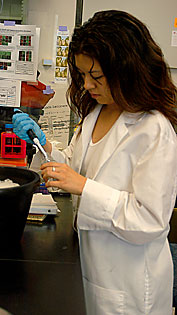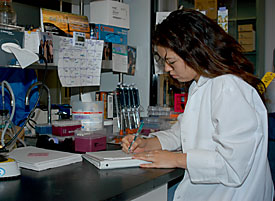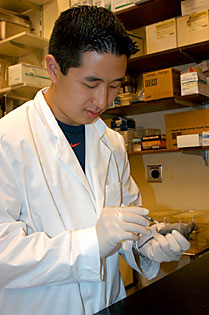 |
|
MELISSA HALTERMAN/Arizona Summer Wildcat
|
Mollecular and cellular biology senior Cyndi Perry dilutes antibodies in the Gregrio Lab at UMC. Perry's research is focused on studying proteins in the heart.
|
|
By Ian Musil
Arizona Summer Wildcat
Wednesday July 30, 2003
Program lets undergrads pursue individual research
Cyndi Perry has always loved to learn. In high school, her favorite subject was marine ecology, and she still remembers the times her teacher would tell her about the wonders of the ocean, as recorded in textbooks and research journals.
By the time she got to college, however, Perry had grown tired of reading books and listening to teachers. She wanted to do her own exploring and pursue her new interest, the human heart.
"I wanted to do my own research," Perry said, "but I didn't know where to start."
Surfing through websites while she was a freshman at NAU, Perry identified the few Arizona programs for undergraduates interested in medical research. Located a few hundred miles south of Flagstaff, Perry found a program that particularly sparked her interest.
At the University of Arizona, Co-director of the Undergraduate Biology Research Program Carol Bender was showing the nation how the resources of a major research university can expand the breadth of an undergraduate education. Designed to help train young scientists through understudy, the Undergraduate Biology Research Program began to draw more of Perry's attention as the summer drew closer.
UBRP's mission was simple: to teach students by giving them the opportunity to do research. Since its beginning in 1989, students in the program worked side-by-side with faculty and researchers on projects than interested both the student and their supervisor.
Officials at the National Science Foundation and The Howard Hughes Medical Institute call UBRP the model program for universities across the country. The first and largest undergraduate research program funded by the National Science Foundation, officials think the UA program is a "prime example" of what universities should be doing to educate young scientists.
 |
|
MELISSA HALTERMAN/Arizona Summer Wildcat
|
Student Researcher Cyndi Perry examines her report for the Gregrio Lab.
|
|
There are now over 100 grants modeled after the award the NSF gave to UBRP 14 years ago. Under the UBRP system designed by Bender and her colleague Michael Wells at the UA, federal funds paid for half of a UBRP's student's salary while faculty were expected to cover the other half. That system still survives today.
"Carol explained the program over the phone," Perry said. "She set me up with a lab and promised I would fit in."
Perry only needed a few weeks in Tucson to realize she'd found a home.
Thirteen students made their homes in UBRP during the program's first year. Since then, the program has grown considerably in funding size and diversity.
In 2002, over 140 undergraduates participated in the program; it now branches out to include faculty from over forty UA departments and four Phoenix research communities. Total funding for the program has exceeded $8 million.
"Carol made me feel comfortable coming to the UA and about being a UBRP student," Perry said. "After a month here, I knew it. I was a perfect fit."
Perry was so happy with her experience that she quickly made the decision to transfer to UA, where, through UBRP, she was already forging life-long friendships.
"Three of my best friends are in UBRP and another works just down the hall from my lab. We are like a family."
The three celebrated birthdays and went to the movies together. They also sought each other out for advice on their personal life and their professional aspirations.
 |
|
That's what I want to do, to create common experiences students can build on outside school.
- Carol Gregorio
professor of cell biology and anatomy
|
 |
"We help each other apply to graduate school," Perry said.
Perry's boss, associate professor of cell biology and anatomy Carol Gregorio, said she tries hard to encourage as much positive UBRP interaction as possible.
"I do everything I can to make sure everyone gets along so that everyone is comfortable with each other," said Gregorio. "Carol (Bender) does a lot to support those efforts. Conferences, poster presentations, travel funding, field trips, seminars. She is incredible. She gets these great students and forms a close, tight family."
The built-in support structure is the element of UBRP Perry enjoyed most. Along with the close professional interaction with mentors in the lab, she attended weekly seminars, career fairs and UBRP field trips.
"It is important for students to feel connected to something in college, a place to fit in, a place to be known," Bender said about Perry's experience. "Whether that's a fraternity, athletics, or UBRP, it is important to focus on common experiences that students can build on outside of school."
UBRP students, like Perry, also reach outside their intimate group to share their science knowledge and experience with the community outside the UA. Many publish and travel the globe to present their research. Perry has been to Boston, Albuquerque, and San Francisco to attend conferences. Several "UBRPers" participate in outreach projects with minority high school students. Bender often attends UA's New Start program during the summer to introduce UA freshmen to the program.
"That's what I want to do, to create common experiences students can build on outside school. Get them to know each other so they can share their similarities and differences. UBRP is meant to prepare students to shine in the world outside the classroom, emotionally and intellectually."
In addition to Bender's attention, Perry said her mentor, Dr. Gregorio, has been a constant source of guidance and has helped her in her search for the right graduate school.
"I am looking into UCSD seriously. Dr. Gregorio did her post-doctorate studies there; she has pointed me in the direction of labs that might be a good fit for me," Perry said.
Perry's experience is not outside the norm. UBRP offers a research experience that is critical for any student who, like Perry, thinks they might be interested in a career in research or medicine.
Students in UBRP account for a large number of undergraduates registered with the Pre-health Professions and Advising Center. Nancy Stiller, coordinator of the center, said a large number of students that she helps apply to medical school, osteopathic school, and dental school need research experience to compete for top spots in competitive programs.
"More and more, medical schools are demanding an understanding of basic research from their applicants. UBRP provides that knowledge. It provides an experience in the basic research critical to patient treatment," said Stiller.
As she plans to apply for both medical school and a doctorate, Perry is glad UBPR is equally beneficial for students interested in graduate study and academic research.
"It helps students decide if they are cut out for this kind of work. A successful UBRP student has already demonstrated that they can survive in a lab setting. That is important to admission boards," said Kevin Bonine, a UBRP alumnus who now teaches courses in the department of ecology and evolutionary biology.
Now a senior, Perry plans to apply to medical school for a joint M.D./Ph.D. program. She's interested in pediatrics and wants to cure her patients' ailing hearts with the knowledge and experience she has gained in the lab.
 |
|
MELISSA HALTERMAN/Arizona Summer Wildcat
|
Devin Kim, cello performance senior, gives a lab mouse an injection as part of his job as a student researcher in the Renal Lab at UMC.
|
|
Funding success
Spending $330 million (26 percent of the total budget) on research in 2002, the UA reaffirmed a dedication to create a research infrastructure that makes a program like UBRP possible. Much of the UA money spent on research pays the salaries of faculty critical to the program.
"There's not a choice," said Alberta Charney, a researcher studying the value of UA expenditures. "In order to bring students to the forefront of knowledge, you have to have faculty at the forefront of knowledge."
The faculty members bring in the grant money that pays for undergraduates to work in labs. More faculty means more money. More money means more opportunities for students
Patrick Blake, a visiting neuroscience junior from Ohio Wesleyan University who participated in UBRP this summer, said he is constantly impressed by the resources that labs like his offer to students doing cutting-edge research.
"Here, I can get pretty much any materials I need in a matter of days. In Ohio, that's not an option," said Blake.
Regents Professor Vicki Chandler employs over 10 undergraduates in her lab and she insists the money the UA spends on research is solely responsible for the vast number of opportunities for undergraduates in Tucson.
"If this money wasn't spent, there wouldn't be any opportunities for students," said Chandler.
In April, top UA administrators furthered their commitment to involving undergraduates in research. Vice President of Research Dick Powell said that month that although the money spent on research contributes to federal awards and economic development in the area, it is UA undergrads that benefit most from research funding.
"Research is an important creative component of their (undergrads') educational experience," Powell said. "Hands-on work is an important way to learn outside the classroom."

